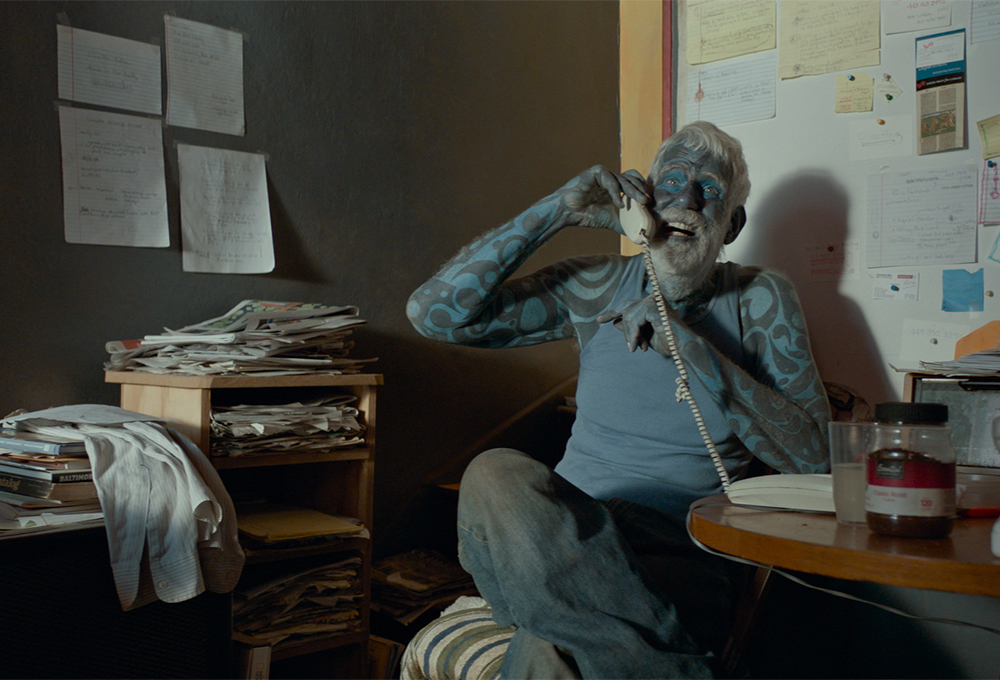
Maybe you’ve seen him on his block in Federal Hill, or somewhere else around Baltimore, a city he helped plan for four decades: the man who is tattooed entirely blue.
His name is Jim Hall, and he began the art project of tattooing his skin blue in the 1960s. He finished tattooing his entire body—save for the bottoms of his feet—40 years later with his face and hands after he retired as a city planner.
Local cinematographer and director Jonathan Bregel met Hall two years ago, when Bregel moved back to Baltimore after spending a decade in New York. Bregel was Hall’s new neighbor in Fed Hill.
“I was walking around and saw this guy sitting up on a hill, and it was shady, but he looked blue,” Bregel says. “I couldn’t tell completely if he was, though. So I just asked him. ‘Are you blue?’ And he was like, ‘Yeah!’ And he started telling me about it. Within 30 minutes, he basically told me everything that makes up the film.”
Last summer, in an effort to tell Hall’s story and to meet other creatives in the area, Bregel and filming partner Steve Hoover joined forces to create a short film about Hall, “out of the blue,” which premiered in January on Vimeo as a Staff Pick.
The duo, known as friendzone, have also submitted the film to the Maryland Film Festival returning in April and—as of publication time—are still waiting to hear whether it has been accepted. Bregel was inspired to create the film after seeing a screening of “Balti-Shorts” at the festival last year, which comprised five Baltimore-made films.
We sat down with Bregel to chat about his admiration for Hall’s openness, exploring judgements of others, and the impact he hopes the film has on audiences.
When did you realize you wanted to make a film about Jim?
I think it was always in my mind from the first time I met him. I just thought, ‘This guy is so unique,’ because on the surface he’s so different from anyone you meet—and the most friendly person. It’s this contradictory experience. You want to judge him in one way because he’s so dramatically different.
It was that flex of emotions and feelings that kept drawing me back to him. But I didn’t know how I wanted to tell the story. That’s when I got Steve involved. Steve’s experience in storytelling was really what made it possible, more or less. From the second I met [Jim], there was a curiosity to explore my own judgements.
Did it take any convincing on your part?
Not really. It just took a lot of patience. He talks for long periods of time and often doesn’t stay on a single track. I was wondering at points, is this going to be possible? But it didn’t take convincing. He was interested. He says we immortalized him. (laughs)
What’s something that you think people should know about Jim that didn’t make it into the movie?
My hope is that people get a sense of how genuine of a guy he is. But something they should know about is his accomplishments in the city of Baltimore. For example, he designed Key Highway. It was his idea. He did the drawings and got the federal funding to make Key Highway. He’s an unsung hero of Baltimore, but he’s so humble. He’s extremely passionate about people and communities.
You spent quite a bit of time with Jim (and still do). How have you seen others react to him when you’re out?
Mainly people just don’t understand that it’s a real tattoo. People get spooked out or get curious. You can see people double-taking all the time. The more I get to know him, I don’t see him so differently anymore. It’s just interesting how judgmental people are. That’s how I initially felt. Now he’s just a guy that just did what he wanted to do.
What do you hope viewers take away from the film?
The old adage of don’t judge a book by its cover. If people are judging him beforehand, I hope afterward, by the end they respect this guy. We wanted to take people on that journey. From comments so far I feel like we’ve accomplished that. Maybe we’ll get people to be less judgmental about others who look different or do things differently.
